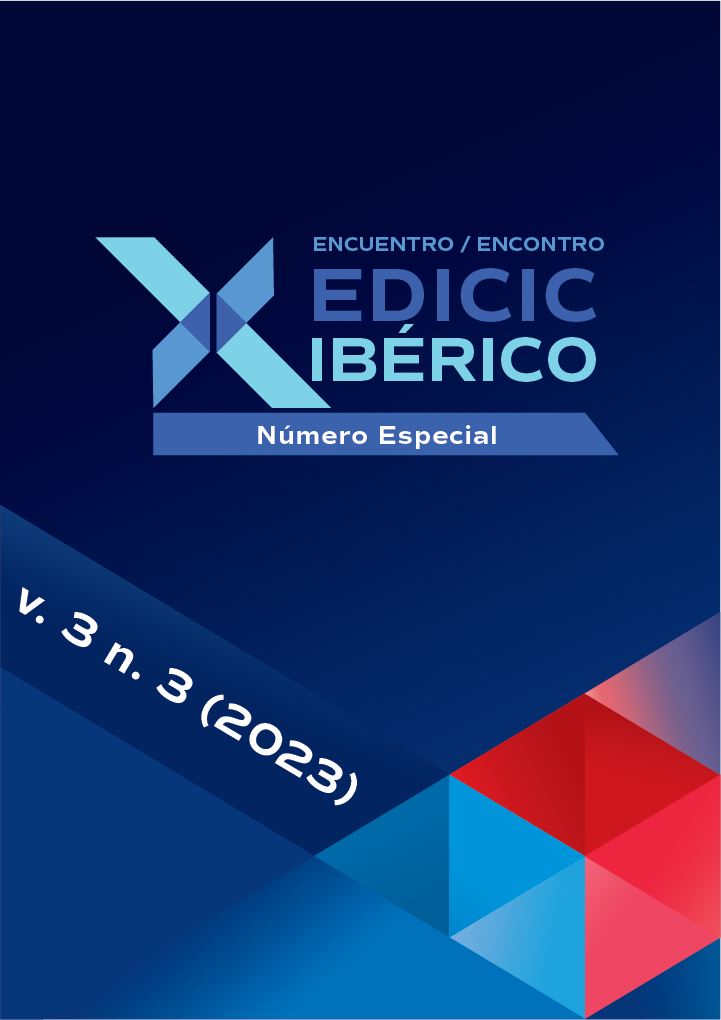Comportamiento informacional estereotipado causado por las redes sociales: un estudio de caso de tiktok
DOI:
https://doi.org/10.62758/re.v3i3.235Palabras clave:
Comportamiento Informacional Estereotipado, Burbujas de Filtro, Cámaras de Eco, Redes Sociales, TikTokResumen
Este estudio profundiza en el fenómeno del comportamiento de información estereotipada en el ámbito de las redes sociales, con un enfoque específico en la plataforma TikTok. Empleando un enfoque multimétodo, nuestro objetivo es desentrañar las dinámicas intrincadas que entran en juego cuando los usuarios interactúan con contenido que puede reforzar creencias y estereotipos existentes. La prevalencia y naturaleza multifacética del comportamiento de información estereotipada se iluminan a través de un análisis exhaustivo de las interacciones de los usuarios en TikTok. Nuestros hallazgos revelan un patrón convincente: los usuarios muestran una tendencia a interactuar con contenido que se alinea con sus creencias preexistentes. Una característica distintiva de TikTok es su formato centrado en lo visual, caracterizado por videos cortos y atractivos. Este aspecto amplifica el potencial para el refuerzo de estereotipos. Las imágenes y los memes, en particular, emergen como herramientas poderosas para la difusión de información tanto precisa como sesgada. Además, nuestra investigación arroja luz sobre la formación de burbujas de filtro y cámaras de eco dentro del ecosistema de TikTok. Los usuarios tienden a estar inmersos en contenido e interacciones que reafirman sus creencias existentes, limitando potencialmente la exposición a perspectivas diversas. Este fenómeno refleja observaciones en otras plataformas de redes sociales y subraya la necesidad de estrategias para fomentar un entorno de información más inclusivo. Esta investigación subraya la apremiante necesidad de continuar investigando sobre cómo las plataformas de redes sociales influyen en el consumo y procesamiento de información. A medida que estas plataformas siguen dando forma al discurso público, es imperativo que los usuarios, creadores de contenido y desarrolladores de plataformas permanezcan vigilantes en sus esfuerzos por mitigar la posible perpetuación de estereotipos.
Citas
Arendt, F. (2023). Media stereotypes, prejudice, and preference-based reinforcement: Toward the dynamic of self-reinforcing effects by integrating audience selectivity. https://doi.org/10.1093/joc/jqad019. DOI: https://doi.org/10.1093/joc/jqad019
Augoustinos, M., & Walker, I. (1998). The Construction of Stereotypes within Social Psychology: From Social Cognition to Ideology. Theory & Psychology, 8(5), 629–652. https://doi.org/10.1177/0959354398085003. DOI: https://doi.org/10.1177/0959354398085003
Beeghly, E. (2015). What is a Stereotype? What is Stereotyping? Hypatia, 30(4), 675–691. https://doi.org/10.1111/hypa.12170. DOI: https://doi.org/10.1111/hypa.12170
Bosco, C., Patti, V., Frenda, S., Cignarella, A. T., Paciello, M., & D’Errico, F. (2023). Detecting racial stereotypes: An Italian social media corpus where psychology meets NLP. Information Processing & Management, 60(1), 103118. https://doi.org/10.1016/j.ipm.2022.103118. DOI: https://doi.org/10.1016/j.ipm.2022.103118
Bruns, A. (2019). Filter bubble. Internet Policy Review, 8(4). https://policyreview.info/concepts/filter-bubble. DOI: https://doi.org/10.14763/2019.4.1426
Cinelli, M., De Francisci Morales, G., Galeazzi, A., Quattrociocchi, W., & Starnini, M. (2021). The echo chamber effect on social media. Proceedings of the National Academy of Sciences, 118(9), e2023301118. https://doi.org/10.1073/pnas.2023301118. DOI: https://doi.org/10.1073/pnas.2023301118
Clark, C. J., & Winegard, B. M. (2020). Tribalism in War and Peace: The Nature and Evolution of Ideological Epistemology and Its Significance for Modern Social Science. Psychological Inquiry, 31(1), 1–22. https://doi.org/10.1080/1047840X.2020.1721233. DOI: https://doi.org/10.1080/1047840X.2020.1721233
Dandekar, P., Goel, A., & Lee, D. T. (2013). Biased assimilation, homophily, and the dynamics of polarization. Proceedings of the National Academy of Sciences, 110(15), 5791–5796. https://doi.org/10.1073/pnas.1217220110. DOI: https://doi.org/10.1073/pnas.1217220110
Davies, H. (2018). Redefining filter bubbles as (escapable) socio-technical recursion. Sociological Research Online, 23(3). https://ora.ox.ac.uk/objects/uuid:c78b6c16-0d9a-44f9-986a-ba4343fa384c.
Ditto, P. H., Liu, B. S., Clark, C. J., Wojcik, S. P., Chen, E. E., Grady, R. H., Celniker, J. B., & Zinger, J. F. (2019). At Least Bias Is Bipartisan: A Meta-Analytic Comparison of Partisan Bias in Liberals and Conservatives. Perspectives on Psychological Science, 14(2), 273–291. https://doi.org/10.1177/1745691617746796. DOI: https://doi.org/10.1177/1745691617746796
Dobson, K., & Knezevic, I. (2018). “Ain’t Nobody Got Time for That!”: Framing and Stereotyping in Legacy and Social Media. Canadian Journal of Communication, 43(3), 381–397. https://doi.org/10.22230/cjc.2018v43n3a3378. DOI: https://doi.org/10.22230/cjc.2019v44n3a3378
Döring, N., Reif, A., & Poeschl, S. (2016). How gender-stereotypical are selfies? A content analysis and comparison with magazine adverts. Computers in Human Behavior, 55, 955–962. https://doi.org/10.1016/j.chb.2015.10.001. DOI: https://doi.org/10.1016/j.chb.2015.10.001
Fosch-Villaronga, E., Poulsen, A., Søraa, R. A., & Custers, B. H. M. (2021). A little bird told me your gender: Gender inferences in social media. Information Processing & Management, 58(3), 102541. https://doi.org/10.1016/j.ipm.2021.102541. DOI: https://doi.org/10.1016/j.ipm.2021.102541
Gouvernement du Québec. (n.d.). Effects of Stereotypes on Personal Development. Retrieved August 13, 2023, from https://www.quebec.ca/en/family-and-support-for-individuals/childhood/child-development/effects-stereotypes-personal-development/definition-stereotypes.
Green, C. (2015, October 15). What are the causes of stereotypes? Getting Race Right. https://blogs.hope.edu/getting-race-right/our-context-where-we-are/the-history-we-inhaled/what-are-the-causes-of-stereotypes/.
Hamilton, D. L. (2015). Cognitive Processes in Stereotyping and Intergroup Behavior. Psychology Press. DOI: https://doi.org/10.4324/9781315668758
Haner, M., Sloan, M. M., Pickett, J. T., & Cullen, F. T. (2020). Safe haven or dangerous place? Stereotype amplification and Americans’ perceived risk of terrorism, violent street crime, and mass shootings. The British Journal of Criminology, 60(6), 1606–1626. DOI: https://doi.org/10.1093/bjc/azaa045
Huber, B., & Baena, L. Q. (2023). Women Scientists on TikTok: New Opportunities to Become Visible and Challenge Gender Stereotypes. Media and Communication, 11(1), 240–251. https://doi.org/10.17645/mac.v11i1.6070. DOI: https://doi.org/10.17645/mac.v11i1.6070
Institut für Sozialarbeit und Sozialpädagogik e.V. Agency. (2022). Fact Sheet 6: Gender stereotypes on social media. Institut für Sozialarbeit und Sozialpädagogik e.V. Agency.
Intravia, J., & Pickett, J. T. (2019). Stereotyping Online? Internet News, Social Media, and the Racial Typification of Crime. Sociological Forum, 34(3), 616–642. https://doi.org/10.1111/socf.12515. DOI: https://doi.org/10.1111/socf.12515
Jones, M., & Sugden, R. (2001). Positive confirmation bias in the acquisition of information. Theory and Decision, 50(1), 59–99. https://doi.org/10.1023/A:1005296023424. DOI: https://doi.org/10.1023/A:1005296023424
Jr, R. S. W., & Srull, T. K. (2014). Handbook of Social Cognition: Volume 2: Applications. Psychology Press.
Kappes, A., Harvey, A. H., Lohrenz, T., Montague, P. R., & Sharot, T. (2020). Confirmation bias in the utilization of others’ opinion strength. Nature Neuroscience, 23(1), Article 1. https://doi.org/10.1038/s41593-019-0549-2. DOI: https://doi.org/10.1038/s41593-019-0549-2
Liu, J. (2021). The Influence of the Body Image Presented Through TikTok Trend-Videos and Its Possible Reasons. 359–363. https://doi.org/10.2991/assehr.k.210609.072. DOI: https://doi.org/10.2991/assehr.k.210609.072
Macrae, C. N., Milne, A. B., & Bodenhausen, G. V. (1994). Stereotypes as Energy-Saving Devices: A Peek Inside the Cognitive Toolbox. Journal of Personality and Social Psychology, 66(1), 37–47. https://doi.org/10.1037/0022-3514.66.1.37. DOI: https://doi.org/10.1037//0022-3514.66.1.37
Maftei, A., & Merlici, I.-A. (2022). Am I thin enough? Social media use and the ideal body stereotype: The mediating role of perceived socio-cultural pressure and the moderating role of cognitive fusion. Current Psychology. https://doi.org/10.1007/s12144-022-02938-x. DOI: https://doi.org/10.1007/s12144-022-02938-x
Matamoros Fernandez, A., Rodriguez, A., & Wikstrom, P. (2022). Humor That Harms? Examining Racist Audio-Visual Memetic Media on TikTok During Covid-19. Media and Communication, 10(2), Article 2. DOI: https://doi.org/10.17645/mac.v10i2.5154
McGregor, S. C. (2019). Social media as public opinion: How journalists use social media to represent public opinion. Journalism, 20(8), 1070–1086. https://doi.org/10.1177/1464884919845458. DOI: https://doi.org/10.1177/1464884919845458
Min, S. J., & Wohn, D. Y. (2020). Underneath the Filter Bubble: The Role of Weak Ties and Network Cultural Diversity in Cross-Cutting Exposure to Disagreements on Social Media. The Journal of Social Media in Society, 9(1), Article 1.
Min, Y., Jiang, T., Jin, C., Li, Q., & Jin, X. (2019). Endogenetic structure of filter bubble in social networks. Royal Society Open Science, 6(11), 190868. https://doi.org/10.1098/rsos.190868. DOI: https://doi.org/10.1098/rsos.190868
Munro, G., & Ditto, P. (1997). Biased Assimilation, Attitude Polarization, and Affect in Reactions to Stereotype-Relevant Scientific Information. Personality and Social Psychology Bulletin, 23, 636–653. https://doi.org/10.1177/0146167297236007. DOI: https://doi.org/10.1177/0146167297236007
Ng, R., & Indran, N. (2023). Videos about older adults on TikTok. PLOS ONE, 18(8), e0285987. https://doi.org/10.1371/journal.pone.0285987. DOI: https://doi.org/10.1371/journal.pone.0285987
Nickerson, R. S. (1998). Confirmation Bias: A Ubiquitous Phenomenon in Many Guises. Review of General Psychology, 2(2), 175–220. https://doi.org/10.1037/1089-2680.2.2.175. DOI: https://doi.org/10.1037//1089-2680.2.2.175
Pariser, E. (2011). The filter bubble: How the new personalized web is changing what we read and how we think. Penguin.
Quillian, L., & Pager, D. (2010). Estimating Risk: Stereotype Amplification and the Perceived Risk of Criminal Victimization. Social Psychology Quarterly, 73(1), 79–104. https://doi.org/10.1177/0190272509360763. DOI: https://doi.org/10.1177/0190272509360763
Rader, E., & Gray, R. (2015). Understanding user beliefs about algorithmic curation in the Facebook news feed. Proceedings of the 33rd Annual ACM Conference on Human Factors in Computing Systems, 173–182. DOI: https://doi.org/10.1145/2702123.2702174
Schmidt, A. L., Zollo, F., Del Vicario, M., Bessi, A., Scala, A., Caldarelli, G., Stanley, H. E., & Quattrociocchi, W. (2017). Anatomy of news consumption on Facebook. Proceedings of the National Academy of Sciences, 114(12), 3035–3039. https://doi.org/10.1073/pnas.1617052114. DOI: https://doi.org/10.1073/pnas.1617052114
Seiter, E. (2006). Stereotypes and the Media: A Re-Evaluation. Journal of Communication, 36, 14–26. https://doi.org/10.1111/j.1460-2466.1986.tb01420.x. DOI: https://doi.org/10.1111/j.1460-2466.1986.tb01420.x
Stangor, C. (1988). Stereotype Accessibility and Information Processing. Personality and Social Psychology Bulletin, 14(4), 694–708. https://doi.org/10.1177/0146167288144005. DOI: https://doi.org/10.1177/0146167288144005
Stephan, W. G. (1989). A Cognitive Approach to Stereotyping. In D. Bar-Tal, C. F. Graumann, A. W. Kruglanski, & W. Stroebe (Eds.), Stereotyping and Prejudice: Changing Conceptions (pp. 37–57). Springer. https://doi.org/10.1007/978-1-4612-3582-8_2. DOI: https://doi.org/10.1007/978-1-4612-3582-8_2
TikTok: Creative Center. (n.d.). Creative Center: One-stop creative solution for TikTok. Retrieved August 30, 2023, from https://ads.tiktok.com/business/creativecenter.
Turner, P., & Turner, S. (2011). Is stereotyping inevitable when designing with personas? Design Studies, 32(1), 30–44. https://doi.org/10.1016/j.destud.2010.06.002 DOI: https://doi.org/10.1016/j.destud.2010.06.002
Unni, Z., & Weinstein, E. (2021). Shelter in Place, Connect Online: Trending TikTok Content During the Early Days of the U.S. COVID-19 Pandemic. Journal of Adolescent Health, 68(5), 863–868. https://doi.org/10.1016/j.jadohealth.2021.02.012. DOI: https://doi.org/10.1016/j.jadohealth.2021.02.012
Xu, W. (2022). (Non-)Stereotypical representations of older people in Swedish authority-managed social media. Ageing & Society, 42(3), 719–740. https://doi.org/10.1017/S0144686X20001075. DOI: https://doi.org/10.1017/S0144686X20001075
Yuen, N. W. (2019, June 4). How Racial Stereotypes in Popular Media Affect People—And What Hollywood Can Do to Become More Inclusive. Scholars Strategy Network. https://scholars.org/contribution/how-racial-stereotypes-popular-media-affect-people-and-what-hollywood-can-do-become.
Descargas
Publicado
Cómo citar
Número
Sección
Licencia
Derechos de autor 2023 Revista EDICIC

Esta obra está bajo una licencia internacional Creative Commons Atribución 4.0.
La Asociación posee los derechos de autor de los textos que publica y adopta la licencia Creative Commons, CC BY 4.0 DEED Atribución 4.0 Internacional (https://creativecommons.org/
Usted es libre de:
- Compartir: copiar y redistribuir el material en cualquier medio o formato para cualquier propósito, incluso comercialmente.
- Adaptar: remezclar, transformar y construir a partir del material para cualquier propósito, incluso comercialmente.






